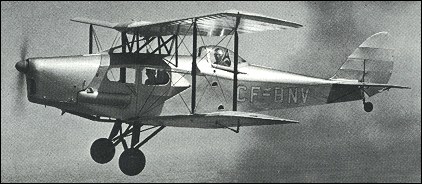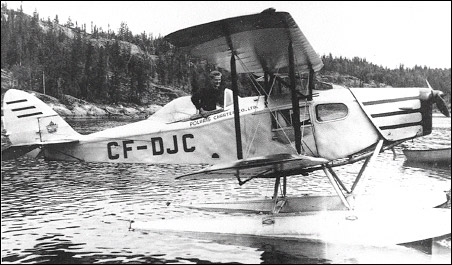|
| De Havilland designer A. E. Hagg
evolved the de Havilland D.H.83 Fox
Moth in 1932 to meet a perceived need
for a light transport aircraft with good
performance, economical operations
and low initial cost. To standard Tiger
Moth components (including wings, tail
unit, landing gear and engine mounting)
he added a new plywood-covered
wooden fuselage, locating the pilot in an
open cockpit behind an enclosed cabin
which accommodated up to four passengers.
The prototype, powered by an
89kW de Havilland Gipsy III
engine, was flown at Stag Lane in March
1932. It was later shipped to Canada for
trials on floats and skis, undertaken in
service with Canadian Airways Ltd. Eight
of the 98 British-built Fox Moths were
exported to Canada between 1932 and
1935, and two more examples were built
by de Havilland Aircraft of Australia.
Many of these were powered by the
Gipsy Major engine and some had sliding
hoods over the cockpit. A single
Japanese-built copy, powered by a
112kW radial engine and known
as the Chidorigo, was flown by the
Japanese Aerial Transport Company.
After the war, in 1946, de Havilland Canada built 52 examples of the
D.H.83C, which had a number of small
improvements including trim tab on the
elevators, an enlarged clear-view hood
over the cockpit and the installation of a
108kW Gipsy Major 1C engine.
Another example of the D.H.83C (there
were no D.H.83A or D.H.83B
variants) was completed by Leavens
Bros Ltd in 1948.
 | A three-view drawing (700 x 580) |
| MODEL | D.H.83 |
| ENGINE | 1 x de Havilland Gipsy Major inline piston engine, 97kW |
| WEIGHTS |
| Take-off weight | 939 kg | 2070 lb |
| Empty weight | 499 kg | 1100 lb |
| DIMENSIONS |
| Wingspan | 9.41 m | 31 ft 10 in |
| Length | 7.85 m | 26 ft 9 in |
| Height | 2.68 m | 9 ft 10 in |
| Wing area | 24.25 m2 | 261.02 sq ft |
| PERFORMANCE |
| Max. speed | 182 km/h | 113 mph |
| Cruise speed | 154 km/h | 96 mph |
| Ceiling | 3870 m | 12700 ft |
| Range | 579 km | 360 miles |
| Jack B Lalonde, e-mail, 13.07.2007 04:17 www.bushplane.com New aircraft ,DH83C Sn#55-1 being built in Sault Ste Marie. Many original parts. Two lower wings yet to be covered. Colour scheme "Parson's Airways" Kenora Ontario -CAN 7 winter project by volunteers of center.
Will fly off Summer 08 on wheels at YAM
Call sign not finalized. reply |
|
Do you have any comments?
|
| 
COMPANY
PROFILE
All the World's Rotorcraft
|








